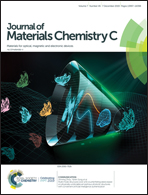Remarkable surface-enhanced Raman scattering on self-assembled {201} anatase†
Abstract
Semiconductors exhibit great potential as a surface-enhanced Raman scattering (SERS) substrate due to their low cost, stability, and biocompatibility. However, their application has been essentially restricted by their intrinsically low SERS sensitivity (10–102). Herein, sea urchin-like TiO2 was obtained by a self-assembled growth of crystals enclosed with the {201} facet. The high-symmetric spiny spheres exhibited appreciable Raman enhancement factors (EFs) of 1.6 × 106, three orders of magnitude higher than those asymmetric TiO2 with exposed {101}, {001}, and {100} facets. The greatest charge transfer upon dopamine adsorption occurred on {201} TiO2 due to its high density of unoccupied t2g orbitals, partly contributing to the excellent SERS performance. More importantly, the sea urchin-like spheres created high-density hotspots evenly distributed in the vicinity of sharp tips and at narrow gaps between the spines, enabling a strong electromagnetic field enhancement (1.4 × 104). Benefiting from the specific electronic and morphologic properties, the self-assembled {201} TiO2 exhibited superior SERS performance in terms of both intensity and reproducibility. The insights gained from this study open a new avenue to improve the SERS performance of semiconductors for applications in biomedical analysis, food detection, and toxicity tests.



 Please wait while we load your content...
Please wait while we load your content...